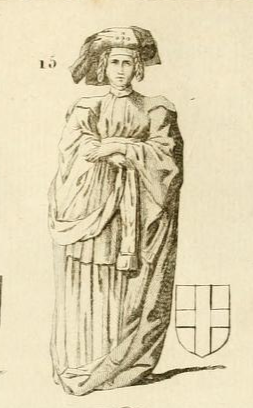
Philip II the Bold was Duke of Burgundy and jure uxoris Count of Flanders, Artois and Burgundy. He was the fourth and youngest son of King John II of France and Bonne of Luxembourg.

Ludovico I or Louis I was Duke of Savoy from 1440 until his death in 1465.

Philip III the Good ruled as Duke of Burgundy from 1419 until his death in 1467. He was a member of a cadet line of the Valois dynasty, to which all 15th-century kings of France belonged. During his reign, the Burgundian State reached the apex of its prosperity and prestige, and became a leading centre of the arts.

John I was a scion of the French royal family who ruled the Burgundian State from 1404 until his assassination in 1419. He played a key role in French national affairs during the early 15th century, particularly in his struggle to remove the mentally ill King Charles VI and during the Hundred Years' War against Kingdom of England. A rash, ruthless and unscrupulous politician, John murdered Charles's brother, the Duke of Orléans, in an attempt to gain control of the government, which led to the eruption of the Armagnac–Burgundian Civil War in France and in turn culminated in his own assassination in 1419.

Charles de Bourbon was the oldest son of John I, Duke of Bourbon and Marie, Duchess of Auvergne.
Jean (John) de Bourbon, Duke of Bourbon, sometimes referred to as John the Good and The Scourge of the English, was a son of Charles I of Bourbon and Agnes of Burgundy. He was Duke of Bourbon and Auvergne from 1456 to his death.

Peter II, Duke of Bourbon, was the son of Charles I, Duke of Bourbon, and Agnes of Burgundy, and a member of the House of Bourbon. He and his wife Anne of France ruled as regents during the minority of Charles VIII of France.

Margaret III was a ruling Countess of Flanders, Countess of Artois, and Countess of Auvergne and Boulogne between 1384 and 1405. She was the last Countess of Flanders of the House of Dampierre.

Margaret of Valois, Duchess of Berry was Duchess of Savoy by marriage to Duke Emmanuel Philibert of Savoy. She was the daughter of King Francis I of France and Claude, Duchess of Brittany.

Margaret of Bourbon was the daughter of Charles I, Duke of Bourbon (1401–1456) and Agnes of Burgundy (1407–1476).

Antoine I de Croÿ, Seigneur de Croÿ, Renty and Le Roeulx, Count of Porcéan, was a member of the House of Croÿ.

Bonne of Berry was a French countess. She was Countess of Savoy by marriage to Amadeus VII, Count of Savoy. When she was widowed, she unsuccessfully claimed the regency during her son's minority against her mother-in-law in 1391–93. As niece of King Charles V of France, she played a key role in French diplomatic maneuvers intended to consolidate the alliances of the kingdom of France.

Margaret of Bavaria was Duchess of Burgundy by marriage to John the Fearless. She was the regent of the Burgundian Low Countries during the absence of her spouse in 1404–1419 and the regent in French Burgundy during the absence of her son in 1419–1423. She became most known for her successful defense of the Duchy of Burgundy against Count John IV of Armagnac in 1419.

Anne of Cyprus was a Duchess of Savoy by marriage to Louis, Duke of Savoy. She was the daughter of King Janus of Cyprus and Charlotte of Bourbon; and a member of the Poitiers-Lusignan crusader dynasty. She was highly influential in the Duchy of Savoy and acted as the political advisor and the de facto ruler on the wish of her spouse.
Jeanne de Bar, suo jure Countess of Marle and Soissons, Dame d'Oisy, Viscountess of Meaux, and Countess of Saint-Pol, of Brienne, de Ligny, and Conversano was a noble French heiress and Sovereign Countess. She was the only child of Robert of Bar, Count of Marle and Soissons, Sire d'Oisy, who was killed at the Battle of Agincourt when she was a baby, leaving her the sole heiress to his titles and estates. In 1430, at the age of fifteen, Jeanne was one of the three women placed in charge of Joan of Arc when the latter was a prisoner in the castle of John II of Luxembourg, Count of Ligny, Jeanne's stepfather.

Margaret of Savoy, also known as Marguerite de Savoie or Margherita di Savoia, was the eldest surviving daughter of Louis I, Duke of Savoy. She was the wife of Margrave John IV of Montferrat, and later the wife of Peter II of Luxembourg, Count of Saint-Pol, of Brienne, Marle, and Soissons.

Mary of Burgundy was a Duchess of Savoy by her marriage to Amadeus VIII of Savoy, who was later known as Antipope Felix V.

Margaret of Savoy, was a daughter of Amadeus VIII of Savoy and Mary of Burgundy. By her three illustrious marriages, she held a number of titles, including Duchess of Anjou, Duchess of Calabria, Countess of Maine, Countess of the Palatinate, and Countess of Württemberg.

Catherine of Bourbon was Duchess of Guelders from 1465-1469 by her marriage to Adolf, Duke of Guelders. She was a daughter of Charles I, Duke of Bourbon and his wife Agnes of Burgundy.

















